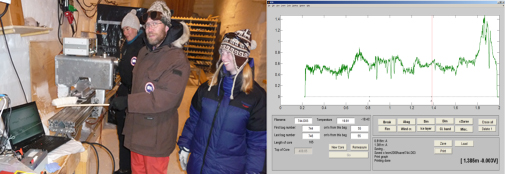Volcanic fingerprints in the ice

To the left the Vesuvius 79 AD eruption is seen as a spike in the ECM record. To the right the acidity spike is indicated on the ECM computer screen by the ice core processors most frequently used tool: the brush. .
Today the science trench processed almost 2000 year old ice and the famous Vesuvius eruption from 79 AD was identified in the Electrical Conductivity Measurement (ECM) at 410 m depth. The ECM signal is a proxy for the acidity of the ice. It shows a peak when the ice has high concentrations of sulphuric acid, which is generally an indication of a volcanic eruption. Because of the proximity to Iceland, Icelandic eruptions are the most frequent in the record, but also Alaskan and Japanese eruptions appear frequently. Eruptions from lower latitudes need to be large in order to make it to Greenland and only the largest Southern Hemisphere eruptions can be identified, as for example Tambora, Indonesia, 1815 AD. Only a fraction of the identified volcanoes have left a visible ash layer in the ice. Many of the major volcanic eruptions identified in the NEEM core are, however, investigated for an occurrence of tiny ash particles (micro tephras) that may be invisible to the naked eye. By analyzing the geochemical composition of tephras the source of the ash particles may be identified.
What we have done today:
- Drilling with the NEEM long drill. Drillers depth: 677.46 m.
- Ice core processing. Depth: 423.50 m.
- CFA analysis. Depth: 133.65 m.
- Continued BAS radar measurements. Radar line to the east of camp is
completed.
- Science trench crew prepared delicious dinner.
Ad.1: Drillers report for June 26 (note that drillers report from now on is delayed one day due to late working hours):
"Today we started two drill shifts split in the time period from 0800 to
2400. We recovered 36.9 meters of brittle zone ice core finishing at a
depth of 656.98 m. Three plus metre runs are common and the cores usually
have several cracks (3-5) when pushed out but the core remains intact in
the core tray."
Weather: Overcast, gentle snow showers, wind speed 9 knots from WSW, temperatures day -7°C, night -12°C.
Field leader, Anders Svensson
| ← Previous entry | Next entry → |

